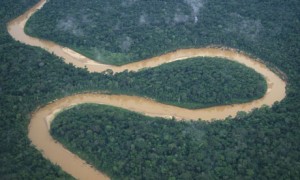
First, the story itself is reported here in the UK’s Guardian, where they write …
The underground river starts in the Acre region under the Andes and flows through the Solimões, Amazonas and Marajó basins before opening out directly into the depths of the Atlantic Ocean.
The Amazon flows much faster than the Hamza, however, draining a greater volume of water. Around 133,000m3 of water flow through the Amazon per second at speeds of up to 5 metres per second. The underground river’s flow rate has been estimated at around 3,900m3 per second and it barely inches along at less than a millimetre per hour.
The Hamza was located using data collected inside a series of 241 abandoned deep wells that were drilled in the Amazon region by the petrochemical company Petrobras in the 1970s and 1980s. Elizabeth Tavares Pimentel and Valiya Hamza of the Department of Geophysics at Brazil‘s National Observatory led the work and presented their results last week at the International Congress of the Society Brasiliera Geophysical in Rio de Janeiro.
OK, a couple of immediate observations:
- It has not been fully confirmed yet. The announcement is based upon preliminary work , they expect to confirm the existence of the flow with additional measurements within the next few years.
- Its not a river in the normal sense. The water is flowing at the rate of 100 meters per year. (The water in the Amazon itself takes about 50 seconds to flow that far). In other words, what you have here is water moving through permeable rock, not in free flow through an underground cave.
- They believe that the origin is in Peru in the Andes mountains
- They have heard from people in the Cuzco region, where the water is closer to the surface, who know the river’s path and use it for wells and even agriculture
- The water drains mostly vertically until 2 km of depth. Near Acre (western Brazil) it becomes more horizontal and follows the same path as the Amazon until the ocean
- The drainage extends 150 km into the Atlantic and can be observed by the salinity of the water as well as the marine life there
- They discovered this by analyzing the temperature in 241 wells dug by Petrobras in the 70s and 80s — the soil temperature was 24 degrees Celsius, but dropped 5 degrees in the water
There is also an Article in nature which helps to greatly clarify things …
calling the water flow an underground river is premature, says hydrogeologist Larry Murdoch of Clemson University in South Carolina. “This sounds like an interesting study that could contribute to the understanding of groundwater in the Amazon Basin,” he says. But “it would be worthwhile trying to explain the temperature measurements in the context of a conventional groundwater flow system before inferring the existence of a new underground river”.
As Hamza himself makes clear, this is not a river in the conventional sense. “This is water flowing through porous rock, mainly sandstone and under that, conglomerate,” he says. Unlike a true river, this underground water flow has “no fixed boundary”.
In summary, what we actually have a study on the regional groundwater flow in the Amazon Basin … so I’m not sure the word “river” is at all appropriate here, its just a discovery of a great big honking aquifer. Why does it matter? Well, the important information is knowing where the water resources are and how they flow so that it can all be managed properly.
Oh and one more thought, the name … the Rio Hamza … they missed a chance there for a far better name such as The Amazunder River, or simply the Amazing river.
Links
- Brazilian article with more details here (sorry no English, but Google translate is your friend)
- Guardian article
- Article in Nature
- For pictures of how the hydrologic system works, the location of the wells used in the study, and an explanation of the physics behind temperature and the correlation to groundwater flow, see the PDF presentation of their study here